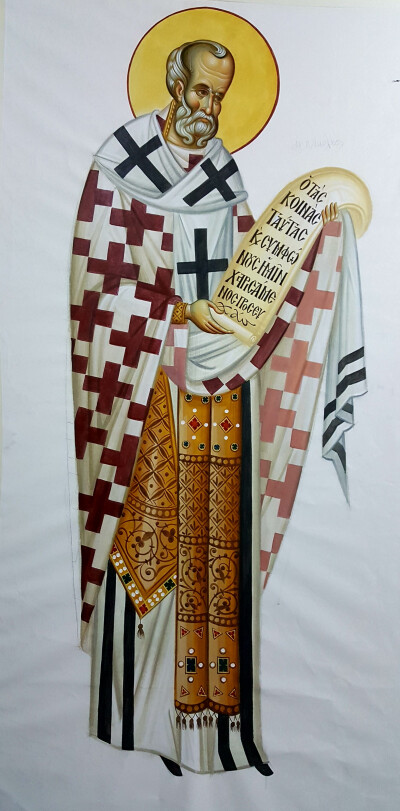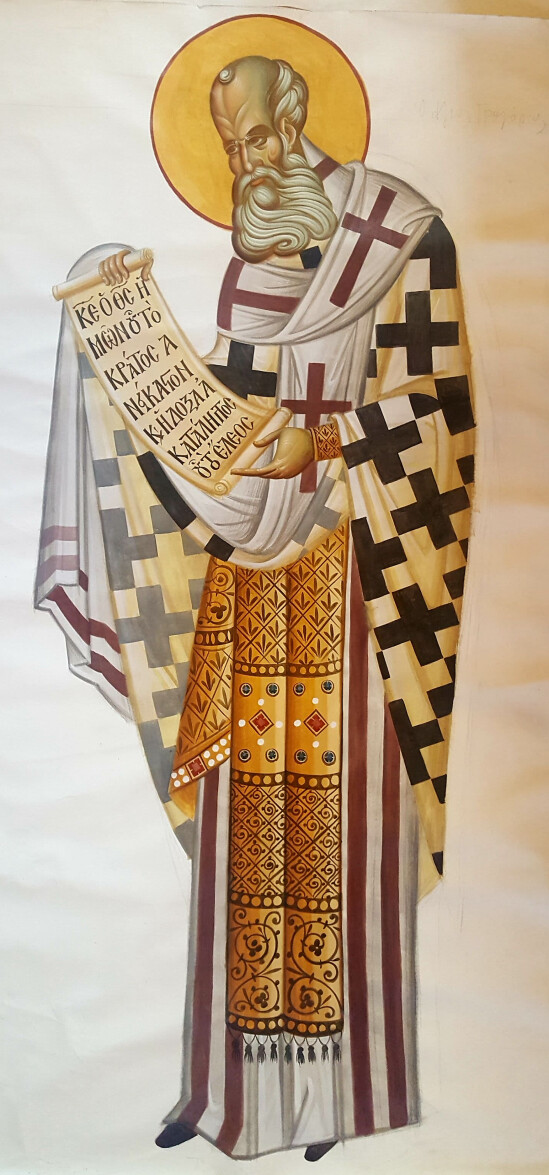THE IMAGES OF THE HOLY HIERARCHS IN THE SANCTUARY OF THE
SAINT NICHOLAS NATIONAL SHRINE AT GROUND ZERO
 |
 |
By His Grace Bishop Joachim of Amissos, PhD
Bishop Joachim of Amissos is an internationally recognized expert in Byzantine Iconography and is the Director of the Archbishop Iakovos Library at Hellenic College/Holy Cross.
One of the main iconographic elements usually found in the sanctuaries of Byzantine/Orthodox churches is the presence of images of saintly Hierarchs at the lowest level of the east wall, closest to the Altar Table itself, and to the actual space occupied by the celebrating clergy. For centuries, the sanctuary space has been regarded as the most sacred part of a church building since it is the place of the Altar on which the Eucharistic gifts are transformed into the true Body and Blood of Christ. As the seventh-century Patriarch Sophronios of Jerusalem wrote in his liturgical commentary, the sanctuary is an image of the heavenly sanctuary, and the Angels celebrate the celestial liturgy, as the living priests do.
As scholars have outlined, following the period of Iconoclasm (726-843), images of grouped bishops were included in the iconographic programs of church sanctuaries as emblems of Orthodoxy and ecclesiastical authority. By the tenth century, it was customary to find images of Saintly Hierarchs on the east wall of the sanctuary, shown frontally and holding closed Gospel books, as seen in the apse of the church of the Panagia ton Chalkeon in Thessalonike, dated to 1028. But by the beginning of the twelfth century, the Holy Bishops were more often rendered in a three-quarter pose, facing the center of the apse and holding open scrolls bearing the opening lines of the various prayers of the Divine Liturgy. This manner of depicting the Holy Hierarchs in the sanctuary would prevail into the late and post-Byzantine periods and is often seen in many contemporary Orthodox churches today.
This iconographic development coincided with the period of the standardization of liturgical practices, as well as with a time which witnessed a greater interest in depicting liturgical ceremonies in all areas of Byzantine art. It reflected the desire for correct liturgical representations and the increasing emphasis on the role of liturgical worship as the means of transformation and transcendence. As scholars have also shown, there exists a twelfth-century text outlining the patriarchal service in Hagia Sophia that describes how liturgical scrolls were unrolled and read by the celebrants at specified moments in the Divine Liturgy. The iconographic Holy Hierarchs now encircle the Holy Altar, and stand in dialogue with the actual clergy to concelebrate the Sacred Mysteries.
The number of saintly bishops depicted can vary, depending on the size of the sanctuary. And the selection of painted Holy Hierarchs could vary as well, depending on a church’s patronal dedication or the traditions of a local hierarchical saint. No matter how small or large, such an iconographic program always included the figures of Saints Basil and John Chrysostom, acknowledging them as the authors of the two major liturgies of the Orthodox Church. Often, the image of Saint Gregory the Theologian is present, referencing him as the traditional author of the Presanctified Liturgy. In the Shrine of Saint Nicholas at Ground Zero, these three figures will appear in the sanctuary, along with that of Saint Nicholas, the Holy Patron of the Shrine. Nicholas, as the most popular saint, after the Theotokos, is often depicted in the sanctuaries of Byzantine/Orthodox churches as one of the concelebrating Holy Hierarchs with his open liturgical scroll, as found in the late twelfth-century frescoes of the church of the Holy Anargyroi in Kastoria Greece, or in those of the church of Saint George, Kurbinovo, North Macedonia, dated to 1191.
This change in the representation of the Holy Hierarchs in church sanctuaries, from frontal, devotional figures, holding closed Gospel books, to that of figures, turned in three-quarter stance, encircling the altar area with open liturgical scrolls, reciting their prayers of the Divine Liturgy, enhances the liturgical realism of the iconography and reinforces the liminal nature of the sacred space-where temporal and eternal rituals are united in the celebration of the Divine Liturgy. The texts on the painted liturgical scrolls of the Holy Hierarchs serve to reinforce the timeless, con-celebratory aspect of the actual priests and bishops with their sacred predecessors. And as various scholars have pointed out, the inscribed prayers enhance the spiritual preparedness of the actual celebrant. The fourteenth-century liturgical commentator, Nicholas Kabasilas, wrote that liturgical prayers spiritually prepare the priest for the Holy Sacrifice and that both clergy and laity benefit from the power of the words themselves.
 |
 |